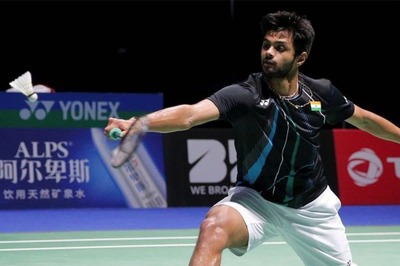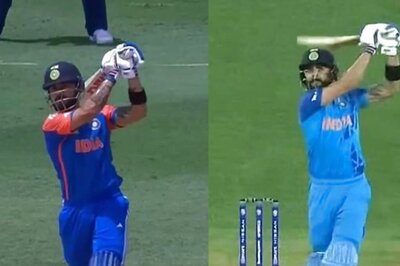
views
Five – is the total number of test wins India have managed against Australia in Australia until the start of the series in 2018. Suffice to say then that a win in Australia is always treasured and long remembered. India was still searching for their first ever series win in Australia as of December 2018.
Apart from the fact that Australian teams have been very good, there are few more reasons why the Indians just don’t win there enough.
- The Batsmen just aren’t used to the pace and bounce of the wickets and have a difficult time adjusting and are thus found wanting
- The same is true for the quicks as well who take a while to figure the right length to bowl. Also, traditionally Indian teams are not known for their pace attack. The spinners too have a difficult time adjusting to tracks that provide ‘lesser’ assistance.
- This has meant that in Australia, the batsmen have not scored enough runs and the bowlers have struggled to take 20 wickets in a test, over the years
Thus, the win in 2003 against Adelaide ranks as one of the most famous wins there. It came against a dominant Australian side which since 1995 were regarded as the best test team in the world. This team had dominated every other both home and away, except India.
In 2001, the India’s had recorded a most famous come from behind series win at home and stopped a sequence of 16 consecutive test victories for the Australian side. Now, in Australia, the Aussies wanted revenge and also wanted to give an appropriate farewell to celebrated captain Steve Waugh who was to retire at the end of the series. While the likes of Hayden, Langer, Ponting, Martyn, Gilchrist and Waugh made for a power packed batting order, crucially, the Australian bowling was without the services of Warne and Mcgrath for this series but still had the likes of Gillespie, Lee and MacGill.
Against them was an Indian team that had a core batting group that had toured Australia before so had experienced the conditions in Sachin, Sourav, VVS, Dravid (had all toured Australia in 1999-2000
) and they were ably supported by Sehwag. The bowling consisted of Zaheer Khan, Nehra, Agarkar, Kumble and a young Irfan Pathan. Plus having done well in India, this team was confident of doing well.
Heading into the test match at Adelaide, the 2nd Test, India had done credibly in Brisbane. Expected to be blown away by the hosts, the tourists did rather well led by captain Ganguly who scored a century. Now, playing on a slower Adelaide pitch, the Indians fancied doing well.
Not the best start to the test match
Confidence was high going into the 2nd test. Adelaide was also considered to be one of the slower pitches in Australia and often played like a flat batting track, with turn in days 4 and 5.
It was always a win toss, bat first pitch, and the Australians did just that.
From the get go, the Australians were in a punishing mood. They lost Hayden early to the debuting Irfan Pathan, but Ponting and Langer kept playing aggressively flaying the attack. Ponting was in the form of his life in 2003-2004 and continued in his menacing form, ably supported by Langer (58), Martyn and Waugh (30 each). Katich joined him and the duo put together a partnership of 138 runs. Katich scored 75 and Australia ended day 1 at a commanding 400/5, Ponting still going strong on 176.
Ponting started day 2 where he left day 1, in total control. He was ably supported by a quickfire 29 by Glichrist and a 48 no. by Gillespie. He eventually got out scoring 242, the team piling up 556. For the Indians – while Kumble got 5/154 and Nehra and Agarkar chipped in with 2 wickets each, one got the feeling that the bowling attacked missed the services of Zaheer Khan who was out injured and had bowled well in the first test.
A decent reply, a wobble and a familiar rear guard
The Indian openers got off to a watchful start and brought up a 50 run partnership. Chopra got out first with the team score at 66, the opening stand should have settled the team nerves but did anything but. Soon enough, the Indians went from 66/1 to 85/4. Sehwag was dismissed for 47 ( of 41 balls), Sachin for 1 and Ganguly run out for 2.
All of a sudden trouble loomed, India had a mountain to climb to reach close to the Aussie total and there were murmurs of an impending ( and potentially innings?) defeat. Laxman joined Dravid in the middle. Steadily and patiently Dravid and Laxman went about their task. They blunted the Australian attack for the rest of the day to take India to 180/4 at close of play.
After starting day 3 sedately, both Dravid and Laxman started to get into their groove. Laxman, in particular, played some lovely strokes, particularly after lunch. Dravid brought up his hundred first, followed by Laxman. Laxman got out just before tea, with the score at 388. A 303 run partnership. The first time ever two players had scored two 250+ run partnerships versus the Aussies. India were still some distance away from the Aussie total. Dravid was batting well and got some good support from the Indian Keeper Parthiv who scored 31, Agarkar and Kumble who scored 23 between them. Dravid was the last man out after scoring 233. The team scored 523 and was all out in reply.
Where the match turned
Sometimes when a team scores a big first innings total it gets lulled into thinking that with little time remaining in the test, a defeat for them would be most unlikely. As of 2003 there were only 4 occasions when a team which scored more than 500 in the first innings lost a test match.
With the match already in day 4 and two full innings to go, a draw seemed the most likely result. However the pitch had deteriorated to a large extent, keeping low and turning as well. The Australians sensed an opportunity to score some-quick runs through the day in the hope to put pressure on the Indians on the last day. They may have felt that an Indian attack which conceded more than 550 in the first innings was there to dominate in the second innings as well.
The hyper aggressive approach also turned a bit counter-productive for the Australians when they lost Langer and Ponting quickly ( Ponting scoring a duck) and when Hayden was dismissed for 17, the team score read 44/3. Martyn and Waugh then started to stitch together a useful partnership and threatened to take the game away from the Indians.
It was then that Ganguly made a crucial decision. Seeing the pitch turn a lot, he introduced Sachin in to the attack. Sachin was woefully out of form in the test series thus far and wanted to have some sort of impact on the match.
This move paid immediate dividend. Sachin was always known for getting big turn and started troubling the batsmen and shortly dispatched both Martyn and Waugh, both caught by Dravid at slip. From a comfortable 109/3, the Aussies slipped to 112/5. But, they did not relent in their aim to put pressure on India. Adam Gilchrist, in the company of Simon Katich, kept playing aggressively. Gilchrist was bowled round his legs by Kumble after scoring a quick fire 43 (of 45 balls only), the team score read 183/6, a lead of 216 and 4 wickets in the shed. The Australians could have kicked on with handy tail enders like Bichel and Gillespie out there to support Katich and hoped to take the lead beyond 300. On the flip side, the Indians sensed the chance to wrap up the innings with a lead of under 250 to have some chance of winning the match.
The man who stepped up for the Indians was the unassuming and ( unlikely) Ajit Agarkar, a bit part support player of the team took centre stage. He had already taken 2 wickets in the innings up to that point, getting Langer and the first innings double centurion Ponting. He bowled with very good control to dismiss Bichel cheaply and a quicker and well directed shorter delivery hurried Katich as he attempted a pull shot and ended up giving a catch in the outfield to Nehra. Agarkar was relentness in his line and length to the tailenders and quickly got rid of Gillespie and MacGill as well to wrap up the Australian Innings on 196. Last four wickets fell for 13 runs, Agarkar picking up a career best 6/41. Australia set up a target of 230 runs for India to chase down.
The Final Flourish
Never easy to chase over 200 in the final innings. ( just ask the current Indian team that folded chasing 283 in Perth 2018) The pitch was wearing down and there will 10 difficult overs to negotiate till end of play. As in the first innings, the openers went about their task sedately and India were 37/0 at close.
A big day 5 lay ahead with both outcomes possible.
Chopra departed early on day 5 and when Sehwag got out attempting a needless shot, the score read 79/2. Dravid was joined in the middle by a struggling ( out of form) Sachin and the Australians sensed an opportunity to get him quickly and send jitters in the Indian dressing room. But Sachin showed strong resolve and both of them stitched together a 70 run partnership, rotating the strike well, and the score read 149 when Sachin got out on 37. India was still 81 runs away from their first win in Australia for 23 years. Sourav Ganguly was dismissed cheaply for 12, but Laxman seemed a man determined and kept peppering the boundary while scoring a rapid 32 of 34 balls with 6 boundaries. When he got out, India was only 9 runs away.
It was apt that Rahul Dravind hit the winning runs when they came (via a handsome square cut to the boundary) and was fittingly not out on 72 to see India through to a famous victory. Those who saw it will always remember Dravid with his hands aloft and taking off the India cap and giving it a kiss on the crest.
It was also the first time that India ever took a lead in a test series in Australia ( to be repeated again in 2018) and for the second series running between the two sides that the Indian team was giving it as they got to the Australian side.
The Australian media and players had said that the Indian team would be rolled over. These talks got even louder when Australia ended day 1 of the first test on 262/2. India fought back well in that match and now this Indian side was up 1-0 in the series.
After beginning the next test well, the Indians floundered to lose it and in the final test they had Australia on the ropes but could not close the deal. The 4 match series ending level 1-1.
It was a team effort that saw India through.
In Dravid and Agarkar there were the lead performers –
Rahul Dravid was the man of the match amassing 305 runs in the match and Agarkar was the hero of the second innings whose spell late on day 4 enabled a dramatic Australian collapse.
There was a solid showing from Laxman who scored a big century in the first innings and his rapid innings decided the fate of the chase in the second innings. Kumble picked up 5 wickets in the first innings.
The openers gave a solid start to the Indians in both innings even though neither of them could kick on.
Ganguly’s inspired choice to make Sachin bowl in the Aussie second innings was a pivotal moment as he got two crucial wickets of set players. This gave Sachin some confidence going into his second innings of the match and he put together a crucial partnership with Dravid when India chased the target.
This was how the famous win in 2003 unfolded and is considered one of the most famous of Indian victories.
Read all the Latest News, Breaking News and Assembly Elections Live Updates here.




















Comments
0 comment